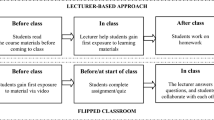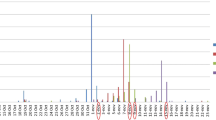Abstract
This study explores the implications of the flipped classroom experiment in South Korea as a counter-proposal for the school innovation project based on the Korean educational context. Using Dongpyung middle school in South Korea for this case study, this paper focuses on how and why the flipped classroom impacts Korea’s education culture. The results of the experiment provide significant insights, such as promoting more active classroom learning and the improvement of student academic achievement. In particular, the narratives of the students and teachers in the flipped classroom experiment show the following positive impacts on learning and teaching: (1) Transformation into a more equal and democratic classroom, (2) restoration of enjoyment in learning and teaching, (3) improvement of self-confidence, and (4) inspiration for the learning and teaching community. Based on these results, this paper discusses possible implications of the flipped classroom as an alternative future class model in Korean society.


Similar content being viewed by others
Notes
“School or classroom collapse” in Korea refers to the mood in schools, in which teachers and students are no longer successfully fulfilling their longstanding respective roles as responsible educators and dutiful learners (Lim 2011).
It should be noted that the interview conducted after finishing the experiment was preferentially conducted with those who showed a very sharp shift in test scores. This choice was based on the supposition that they would have specific empirical narratives concerning the meaning and effectiveness of the flipped classroom.
Following the Korean social experiment in 2014, a nationwide teacher community was created in Korea named “Teachers seeking future classrooms”. https://www.futureclassnet.org.
Korea is ranked among the top 1–8 countries in math, reading and science in the OECD countries and among the top 4–14 countries globally. However, Korean students showed very low levels of satisfaction with their school life (OECD 2016).
References
Bergmann, J., & Sams, A. (2012). Flip your classroom: reach every student in every class every day. Washington, DC: International Society for Technology in Education.
Bhagat, K. K., Chang, C. N., & Chang, C. Y. (2016). The impact of the flipped classroom on mathematics concept learning in high school. Educational Technology and Society, 19(3), 134–142. https://www.researchgate.net/publication/286047548_The_Impact_of_the_Flipped_Classroom_on_Mathematics_Concept_Learning_in_High_school. Accessed 02 Apr 2017.
Chao, C. Y., Chen, Y. T., & Chuang, K. Y. (2015). Exploring students’ learning attitude and achievement in flipped learning supported computer aided design curriculum: a study in high school engineering education. Computer Applications in Engineering Education, 23(4), 514–526.
Chen, H. L., & Summers, K. L. (2015). Developing, using, and interacting in the flipped learning movement: gaps among subject areas. The International Review of Research in Open and Distributed Learning, 16(3), 41–63.
Chen, Y., Wang, Y., & Chen, N. S. (2014). Is FLIP enough? Or should we use the FLIPPED model instead? Computers and Education, 79, 16–27.
Chi, D. L., Pickerell, J. E., & Reidy, C. A. (2014). Student learning outcomes associated with video vs paper cases in a public health dentistry course. Journal of Dental Education, 78(1), 24–30. http://www.ncbi.nlm.nih.gov/pubmed/24385521. Accessed 12 Apr 2017.
Choe, E., & Seong, M. H. (2016). A case study of the flipped classroom in a Korean university general English course. Journal of Pan-Pacific Association of Applied Linguistics, 20(2), 71–93.
Cho-Han, H. J. (1997). The young who reject school, society which reject the young. Seoul: Alternative Culture Press. (In Korean).
Christensen, C., Johnson, C. W., & Horn, M. B. (2008). Disrupting class: how disruptive innovation will change the way the world learns. New York: McGraw-Hill.
Chung, B. H., Kim, C. H., Lee, S. K., & Lee, M. K. (2008). Why educational reform has not Succeed?. Seoul: Changbi. (In Korean).
Chung, Y. S., & Lee, M. K. (2008). A study on the types and characteristics of latent school dropout. Journal of Korean Education, 35(1), 79–102. (In Korean).
Davies, R. S., Dean, D. L., & Ball, N. (2013). Flipping the classroom and instructional technology integration in a college-level information systems spreadsheet course. Educational Technology Research and Development, 61(4), 563–580.
Estes, M. D., Ingram, R., & Liu, J. C. (2014). A review of flipped classroom research, practice, and technologies. International HETL Review 4(7). https://www.hetl.org/feature-articles/a-review-of-flipped-classroom-research-practice-and-technologies. Accessed 09 Apr 2017.
Halili, S. H., & Zainuddin, Z. (2015). Flipping the classroom: what we know and what we don’t. The Online Journal of Distance Education and e-Learning, 3(1), 28–35.
Heo, H. J., & Chun, B. A. (2016). A Study on the Effects of mobile-based LMS on flipped learning: focused on the affective pathway in pre-service teacher education. International Journal of Software Engineering and its Applications, 10(12), 473–484. http://www.sersc.org/journals/IJSEIA/vol10_no12_2016/39.pdf. Accessed 4 Sept 2017.
Ho, D., Lee, M., & Teng, Y. (2016). Exploring the relationship between school-level teacher qualifications and teachers’ perceptions of school-based professional learning community practices. Teaching and Teacher Education, 54, 32–43.
Huang, Y. N., & Hong, Z. R. (2016). The effects of a flipped English classroom intervention on students’ information and communication technology and English reading comprehension. Educational Technology Research and Development, 64(2), 175–193.
Huber, E., & Werner, A. (2016). A review of the literature on flipping the STEM classroom: preliminary findings. In S. Barker, S. Dawson, A. Pardo, & C. Colvin (Eds.), Show Me The Learning. Proceedings ASCILITE 2016 Adelaide (pp. 267–274).
Kaufmann, J. C. (1996). L’entretien compréhensif. Paris: Nathan.
Keddie, N. (1971). Classroom knowledge. In M. Young (Ed.), Knowledge and control (pp. 133–160). London: Collier Macmillan LTd.
Kim, M. S. (2003). Teaching and learning in Korean classrooms: the crisis and the new approach. Asia Pacific Education Review, 4(2), 140–150.
Kim, J. W. (2004). Education reform policies and classroom teaching in South Korea. International Studies in Sociology of Education, 14(2), 125–146.
Kim, M. K., & Shin, C. W. (2016). The effects of flipped classroom on middle school learners English academic achievement and affective domains. Journal of Secondary education, 64(2), 289–314. (In Korean).
Lage, M. J., Platt, G. J., & Treglia, M. (2000). Inverting the classroom: a gateway to creating an inclusive learning environment. Journal of Economic Education, 31(1), 30–43.
Lakmal, A., & Dawson, P. (2015). Motivation and cognitive load in the flipped classroom: definition, rationale and a call for research. Higher Education Research and Development, 34(1), 1–14.
Lee, Y. M. (2010). Views on education and achievement: Finland’s story of success and South Korea’s story of decline. KEDI Journal of Educational Policy, 7(2), 379–401.
Lee, M. K. (2014a). Case study on effects and signification of flipped classroom. Journal of Korean Education, 41(1), 87–116. (In Korean).
Lee, M. K. (2014b). Signification of flipped classroom by sociology of classroom: focusing on the experience of teachers. Korean Journal of Sociology of Education, 24(2), 181–207. (In Korean).
Lee, M. K. (2016). In defiance of school education: retrospective narratives of the new generation of dropout youth in Korea. Korea Journal, 56(3), 33–62.
Lee, J. M., & Park, H. K. (2016). Analysis of flipped learning in K-12 education. Journal of Digital Convergence, 14(8), 19–36. (In Korea).
Lim, J. H. (2011). South Korea’s ‘school collapse’ debates: experiments in South Korean education. In N. Abelmann, J.-A. Choi, & S. J. Park (Eds.), No alternatives? (pp. 45–73). Berkeley: University of California Press.
Lo, C. K., & Hew, K. F. (2017). A critical review of flipped classroom challenges in K-12 education: possible solutions and recommendations for future research. Research and Practice in Technology Enhanced Learning, 12(1), 1–22.
Morin, E. (1992). La méthode 3. la connaissance de la connaissance. Paris: Seuil.
Morin, E. (2000). Les sept savoirs nécessaires à l’education du futur. Paris: Seuil.
Mucchielli, A. (1991). Les méthodes qualitatives. Paris: PUF.
OECD(2005). The definition and selection of key competencies: executive summary. http://www.oecd.org/pisa/35070367.pdf.Accessed. Accessed 12 Sept 2015.
OECD. (2009). Highlights from education at a glance. Paris: OECD.
OECD. (2013). PISA 2012 results in focus: what 15-year-olds know and what they can do with what they know. Paris: OECD.
OECD. (2016). PISA 2015 results in focus: what 15-year-olds know and what they can do with what they know. Paris: OECD.
Oh, O. W. (2009). Using imagination to trace causes of the failure of educational policies in Korea. The Journal of Educational Research, 47(4), 98–117. (In Korean).
Ormrod, J. E. (2006). Educational psychology: developing learners (5th ed.). Upper Saddle River: Pearson/Merrill Prentice Hall.
Paille, P., & Mucchielli, A. (2003). L’analyse qualitative en sciences humaines et sociales. Paris: Armand Colin.
Pang, N.-S. K., & Wang, T. (2016). Professional learning communities: research and practices across six educational systems in the Asia-pacific region. Asia Pacific Journal of Education, 36(2), 193–201.
Partnership for 21st century skills (2015). P21 Framework definitions. http://www.p21.org/storage/documents/docs/P21_Framework_Definitions_New_Logo_2015.pdf. Accessed 17 Oct 2015.
Ripley, A. (2013). The smartest kids in the world and how they got that way. New York: Simon and Schuster.
Robinson, K., & Aronica, L. (2015). Creative schools: the grassroots revolution that’s transforming education paperback. New York: Penguin Books.
Roth, G. (2016). Teachers motivation to teach and students motivation to learn: a self-determination theory analysis, worldwide education initiative: creativity, character education, and curriculum integration. Paper presented at the 2016 70th anniversary of teachers college, Kyungpook national university secondary education Institute international conference, Daegu, Korea.
Salina, L., Ruffinengo, C., & Garrino, L. (2012). Effectiveness of an educational video as an instrument to refresh and reinforce the learning of a nursing technique: a randomized controlled trial [Abstract]. Perspectives on Medical Education, 1 (2), 67–75. http://link.springer.com/article/10.1007%2Fs40037-012-0013-4. Accessed 04 Sept 2017.
Schultz, D., Duffield, S., Rasmussen, S. C., & Wageman, J. (2014). Effects of the flipped classroom model on student performance for advanced placement high school chemistry students. Journal of Chemical Education, 91(9), 1334–1339.
Shin, Y. J., & Ha, J. H. (2016). Analysis of science teachers’ perception of flipped learning. Journal of Teaching, 20(2), 152–167. (In Korean).
Shin, Y. J., Ha, J. H., & Lee, S. H. (2016). An analysis of the perceptions and difficulties experienced by science teachers in flipped learning. Journal of the Korean Association for Research in Science Education, 36(1), 159–166. (In Korean).
Sohng, H. S., & Seo, S. Y. (2016). Effects of project-based flipped classroom on the affective attitude and metacognitive learning strategies of pre-service teachers of English. English Language and Literature, 22(2), 167–192.
Strayer, J. F. (2007). The effects of the classroom flip on the learning environment: a comparison of learning activity in a traditional classroom and a flip classroom that used an intelligent tutoring system. USA: The Ohio State University.
Strayer, J. F. (2012). How learning in an inverted classroom influences cooperation, innovation and task orientation. Learning Environments Research, 15(2), 171–193.
Suh, M. (2016). The effect and awareness of the flipped classroom approach through mixed methods. Journal of Educational Technology, 32(3), 535–570. (In Korean).
Sung, Y. K., & Lee, H. B. (2014). Sleeping students in class: a grounded theory study on the phenomenon of students disengagement. Korean Journal of Sociology of Education, 24(1), 147–171. (In Korean).
Touraine, A. (1995). Critique de la modernité. Paris: Fayard.
Um, K. H. (2013). Teachers also fear the school. Seoul: Gyoyukgongdongchebeot. (In Korean).
Vaismoradi, M., Turunen, H., & Bondas, T. (2013). Content analysis and thematic analysis: implications for conducting a qualitative descriptive study. Nursing and Health Sciences, 15(3), 398–405.
Wagner, T. (2014). The global achievement gap: why even our best schools don’t teach the new survival skills our children need- and what we can do about it. New York: Basic Books.
Watkins, C. (2005). Classroom as learning community. London: Routledge.
Author information
Authors and Affiliations
Corresponding author
Ethics declarations
Conflict of interest
Author declares that there is no conflict of interest.
Additional information
This study is based on the Korea Broadcast System (KBS) Program “Educational revolution in the Twenty-first century: searching for the future classroom”. This study was funded by a faculty research grant from Daegu University (Grant Number 20160018).
Rights and permissions
About this article
Cite this article
Lee, MK. Flipped classroom as an alternative future class model?: implications of South Korea’s social experiment. Education Tech Research Dev 66, 837–857 (2018). https://doi.org/10.1007/s11423-018-9587-9
Published:
Issue Date:
DOI: https://doi.org/10.1007/s11423-018-9587-9




